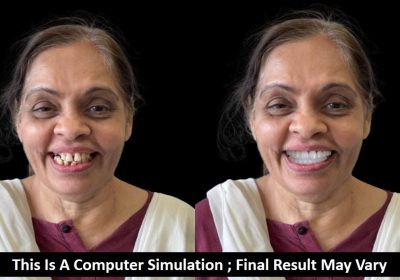Restoring A Faulty Smile with Emax Dental Veneers
Emax veneers are a type of dental veneer made from a high-quality ceramic material known as lithium disilicate. These veneers are used to enhance the appearance of your teeth and create a more aesthetically pleasing smile. Here's what you should know as a patient: 1. **Purpose**: Emax veneers are primarily used for cosmetic purposes. They can help improve the appearance of teeth that are discolored, stained, chipped, misshapped, or have small gaps between them. They are custom-made to blend seamlessly with your natural teeth. 2. **Material**: Emax veneers are made from lithium disilicate, a type of ceramic known for its strength, durability, and lifelike appearance. This material is highly translucent, which means it mimics the natural look of teeth exceptionally well. 3. **Process**: The process of getting Emax veneers typically involves the following steps: - Consultation: You'll discuss your goals and expectations with your dentist, who will examine your teeth to determine if Emax veneers are suitable for you. - Preparation: A small amount of enamel is usually removed from the front surface of the teeth receiving veneers. This allows for a proper fit and ensures the veneers don't make your teeth appear bulky. - Impressions: Your dentist will take impressions of your prepared teeth, which will serve as a model for crafting the custom veneers. - Temporary Veneers: Temporary veneers may be placed on your teeth while the permanent Emax veneers are being fabricated in a dental laboratory. - Bonding: Once your custom veneers are ready, they are carefully bonded to your teeth using a special adhesive, resulting in a beautiful and natural-looking smile. 4. **Appearance**: Emax veneers are highly regarded for their ability to mimic the translucency and natural appearance of teeth. They can be customized in terms of color and shape to achieve the smile you desire. 5. **Durability**: Emax veneers are known for their strength and resistance to staining. With proper care and maintenance, they can last for many years. 6. **Maintenance**: It's important to maintain good oral hygiene habits, including regular brushing and flossing, to keep your Emax veneers looking their best. Avoid biting into hard objects and habits like nail-biting or chewing on ice to prevent damage. 7. **Consultation**: If you're interested in Emax veneers, the first step is to consult with a dentist experienced in cosmetic dentistry. They will assess your oral health and discuss your options, helping you make an informed decision. Remember that while Emax veneers can significantly enhance your smile, they are a permanent alteration to your teeth. It's crucial to have a thorough discussion with your dentist and carefully consider your goals and expectations before proceeding with this cosmetic dental treatment. A lady visits us from the UK. She has irregularly aligned teeth. There are also gaps in between her teeth. She is evaluated on the principles of DSD ( Digital Smile Designing) Emax Dental Veneers are planned and custom-fabricated. A comprehensive smile design is virtually done. She is delighted to envision her perfect smile simulation without actually undergoing any treatment. Her treatment is completed in just 3 visits, within a span of one week interspersed with a short holiday to Goa. Dental Veneers are a great way to create heartwarming Smiles! Her results are stunning. She is extremely happy which can be seen in her Testimony.
Full Mouth Rehabilitation with Dental Implants
Full mouth rehabilitation with dental implants is a comprehensive dental procedure designed to restore the entire mouth's function, aesthetics, and health by using dental implants as the primary treatment modality. This treatment approach is typically reserved for individuals with extensive dental problems, including multiple missing teeth, severe tooth decay, advanced gum disease, or a combination of these issues. Full mouth rehabilitation with dental implants aims to provide a long-lasting, stable, and natural-looking solution for such patients. Here's an overview of what this procedure entails: 1. **Assessment and Planning**: The process begins with a thorough assessment of the patient's oral health. X-rays, scans, and clinical examinations are conducted to determine the extent of dental issues and the suitability of dental implants. A detailed treatment plan is then created, outlining the number of implants required and the type of dental restorations needed. 2. **Implant Placement**: Dental implants, which are artificial tooth roots typically made of biocompatible materials like titanium, are surgically placed into the jawbone. The number of implants and their precise locations depend on the patient's individual case. Local anesthesia is used during this procedure, and sedation options may be available for anxious patients. 3. **Healing and Osseointegration**: After implant placement, a crucial healing period follows. During this time, which can last several months, the dental implants integrate with the surrounding bone through a process called osseointegration. This fusion ensures the implants are securely anchored in the jawbone, providing a stable foundation for the prosthetic teeth. 4. **Abutment Placement**: Once osseointegration is complete, small connector pieces called abutments are attached to the implant posts. These abutments serve as a link between the dental implants and the final restorations. 5. **Final Restorations**: After the gum tissues have healed around the abutments, custom-made dental restorations (such as crowns, bridges, or dentures) are fabricated. These restorations are designed to mimic the appearance and function of natural teeth, and they are securely attached to the abutments. 6. **Ongoing Maintenance**: Proper oral hygiene and regular dental check-ups are crucial for the long-term success of full mouth rehabilitation with dental implants. Patients are typically provided with guidance on how to care for their new teeth, and they should follow a strict maintenance routine to ensure the longevity of their dental implants. Advantages of Full Mouth Rehabilitation with Dental Implants: 1. **Improved Functionality**: Dental implants offer stability and strength, enabling patients to eat, speak, and chew with confidence, similar to natural teeth. 2. **Enhanced Aesthetics**: The restorations used in this procedure are customized to look and feel like natural teeth, significantly improving the appearance of the smile. 3. **Long-Term Solution**: With proper care, dental implants can last for many years, often a lifetime, making them a cost-effective option in the long run. 4. **Preservation of Jawbone**: Implants stimulate the jawbone, preventing bone loss and maintaining facial structure over time, which is a common concern with traditional dentures. 5. **Comfort and Convenience**: Unlike removable dentures, dental implants are fixed in the mouth, eliminating discomfort and inconvenience associated with removable prosthetics. 6. **Improved Oral Health**: Full mouth rehabilitation can enhance oral health by preventing the shifting of remaining natural teeth and reducing the risk of gum disease. In summary, full mouth rehabilitation with dental implants is a transformative dental procedure that provides patients with a functional, aesthetically pleasing, and long-lasting solution for complex dental issues involving multiple missing teeth or extensive dental damage. It combines advanced surgical techniques with customized dental restorations to create a healthy, confident smile. A patient reports for replacement of a few missing teeth. On Examination it was found : 1]Posterior teeth were fractured and missing. 2]Anterior teeth were mobile. 3]Patient was chewing only with the front teeth. A thorough examination was done with Extra Oral Photographs, Intra Oral Photographs, CBCT Scan, 3D Scan with 3 Shape Scanner.OPG Scan, Various measurements like Vertical Dimensions, Smile Line, etc. A treatment plan was devised based on the principles of DSD[ Digital Smile Designing]. Digital technology was used to determine the final positions and look of Smile before actually doing it in the patient mouth. The surgery was done in just 2 visits, one for each jaw.[UPPER & LOWER]




